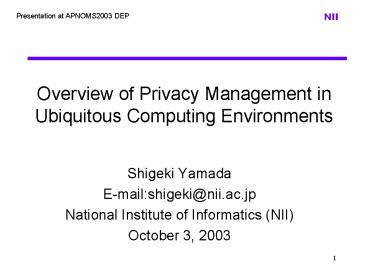Overview of Privacy Management in Ubiquitous Computing Environments - PowerPoint PPT Presentation
Title:
Overview of Privacy Management in Ubiquitous Computing Environments
Description:
New privacy protection technologies are required for ubiquitous environments ... (Data User) Little control over how her data will be used. Data Copy. NII. 4 ... – PowerPoint PPT presentation
Number of Views:25
Avg rating:3.0/5.0
Title: Overview of Privacy Management in Ubiquitous Computing Environments
1
Overview of Privacy Management in Ubiquitous
Computing Environments
Presentation at APNOMS2003 DEP
- Shigeki Yamada
- E-mailshigeki_at_nii.ac.jp
- National Institute of Informatics (NII)
- October 3, 2003
2
Why is Privacy ManagementImportant in Ubicomp
Environments?
- Two major concepts of ubiquitous computing
- Ubiquity
- Invisibility
- Invisibility requires context-awareness that
captures and interprets user context - User context includes privacysensitive personal
data such as users location, activity status,
and preferences - New privacy protection technologies are required
for ubiquitous environments - Dynamic changes of users computing and
communication environments
3
Privacy Invasions in Ubicomp Environments
Bob (Data Collector)
Improper use of Alices personal data
Data Collection
Data Copy
Little control over how her data will be used
Unauthorized use of Alices personal data
Alice (Personal Data Owner)
Carol (Data User)
4
Privacy Management Issues
- Where to store personal data?
- End-User Centric Architecture (ECA)
- Into stationary servers and devices
- Into wearable servers and devices
- Network- Centric Architecture (NCA)
- Who manages privacy?
- User, Network Operator, or Service Provider
- How to protect privacy?
- Principle of Minimum Asymmetry
- P3P and pawS system
- Other technologies
5
Context Data Storage Management ECA (End-User
Centric Architecture)
- User context data are stored in user facilities
and managed by users or service providers - Users feel easy
- User has all the responsibility
LAN
(18)
Contents/ Services Server
WLAN
Internet
R
(17)
ISP Network
(19)
(20)
MT
AP
R
R
(6)
(11)
LAN
R
(5)
(12)
UTRAN
DA
PS-CN
(8)
(7)
(1)
(2)
(4)
(3)
(10)
(9)
RNC
BS
MT
SGSN
GGSN
UCN
(16)
(13)
(15)
(14)
6
Context Data Storage ManagementNCA (Network
Centric Architecture)
- User context data are stored inside the 3GPP All
IP Network managed by Network Operators - Secure and uniform management
- Users may feel uneasy
LAN
(23)
WLAN
Contents/ Services Server
Internet
ISP Network
R
(22)
MT
AP
R
R
(25)
(24)
(21)
DA
(26)
PS-CN
UTRAN
(11)
(12)
(3)
IMS
UCN
(1)
(2)
(4)
(5)
(13)
RNC
BS
MT
SGSN
P-CSCF
GGSN
(10)
(7)
(8)
(18)
(20)
(17)
(16)
(19)
S-CSCF
(6)
(15)
(9)
I-CSCF
(14)
7
Design Space for Privacy Protection
Data Collector (Service Provider or web site)
Access
Prevention Avoidance Detection
Data Collection
Second Use
Prevention Avoidance Detection
Prevention Avoidance Detection
Personal Data Owner
Data User
8
Classification of Privacy Protection Technologies
(by X. Jiang (UCB))
RBAC
Anonymization Pseudonymization
Location Support
Prevention
Wearables
P3P
User Interfaces for Feedback, Notification, and
Consent
Avoidance
Privacy Millers
Detection
Collection
Access
Second use
9
Principle of Minimum Asymmetry
Data Collector (Service Provider or web site)
- Decrease (e.g. anonymization and
pseudonymization)
Decrease (e.g. lower rate of updating location
information)
Increase (e.g. logging of accesses)
Increase (e.g. notification of second use)
Data User
Personal Data Owner
10
Platform for Privacy Preferences Project (P3P)
- Developed by World Wide Web Consortium (W3C)
- Web sites disclose their privacy policies in a
standard XML format - Web browsers automatically retrieve P3P privacy
policies and compare them to privacy preferences
of personal data owners
11
P3P Protocol
Web
Server
12
pawS a Privacy Protection System (ETH)
Privacy Proxy
- (3) Privacy Policy Download
Service Proxy
(4) Comparison of Privacy Policy with User
Preferences
(5)Personal Data
(2) Personal Data Service Name
(1) Service Announcement
Privacy Beacon
Privacy Assistant
13
Mobile Agent-based Privacy System for
Controlling Second Use (NII)
Service Proxy
Privacy Proxy
Privacy Capsule
Privacy Policy
(3) Policy Download (4) Agent Migration
Users Preferences
Mobile Agent
Mobile Agent
Personal Data
(5) Execution Results
(6)
(2)
(1)
Privacy Beacon
Privacy Assistant
14
Other Privacy Protection Technologies
- Location Support System the Cricket system MIT
- Allows client to learn their location without
centralized tracking to construct
location-specific queries - Wearables
- Use persons own workstations Xerox PARC or
wearable computers MIT to store personal data - Privacy Miller (Georgia Tech)
- Shows end-users what information is being
collected, and what information has been accessed
and by whom. - Helps end-users avoid risky situations
15
Concluding Remarks
- Privacy management will be increasingly important
in ubiquitous computing networks - Numerous privacy protection and management
technologies have been emerging - No simple solution but integration of various
technologies for managing privacy - Non-technical aspects must also be considered

